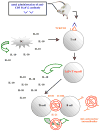Induction of mucosal tolerance in SLE: a sniff or a sip away from ameliorating lupus?
- PMID: 18938110
- PMCID: PMC2652653
- DOI: 10.1016/j.clim.2008.08.028
Induction of mucosal tolerance in SLE: a sniff or a sip away from ameliorating lupus?
Abstract
Systemic lupus erythematosus (SLE) is an autoimmune disease characterized by aberrant immune responses against intracellularly derived self antigens. Treatment for SLE relies on the use of aggressive immunosuppressants and steroids that are nonspecific and can cause serious adverse effects. The observation that a systemic immune tolerance to self antigens or generation of regulatory T cells may follow mucosal (nasal or oral) exposure to self proteins or monoclonal antibody against CD3 respectively suggests that induction of mucosal tolerance offers the basis of a side effect-free therapy that could re-establish the ability to distinguish self from non-self and restore peripheral tolerance in individuals susceptible to developing autoimmune diseases. Here I review studies on mucosal tolerance in autoimmune diseases and discuss the therapeutic potential of inducing tolerance for the treatment of SLE.
Figures


Similar articles
-
Regulatory T Cells in SLE: Biology and Use in Treatment.Curr Rheumatol Rep. 2016 Nov;18(11):67. doi: 10.1007/s11926-016-0616-6. Curr Rheumatol Rep. 2016. PMID: 27704250 Review.
-
[IL-2-Therapy in SLE- Selective reconstitution of immunological tolerance].Z Rheumatol. 2016 Jun;75(5):490-2. doi: 10.1007/s00393-016-0129-8. Z Rheumatol. 2016. PMID: 27250490 German. No abstract available.
-
[Strategic dominance of the mucosal immune system in the defence and tolerance].Cas Lek Cesk. 2011;150(9):480-8. Cas Lek Cesk. 2011. PMID: 22132615 Review. Czech.
-
Low-Dose IL-2 in the Treatment of Lupus.Curr Rheumatol Rep. 2016 Nov;18(11):68. doi: 10.1007/s11926-016-0617-5. Curr Rheumatol Rep. 2016. PMID: 27734211 Review.
-
[Inducing tolerance against antigens through initial contact via the mucous membrane].Ned Tijdschr Geneeskd. 2002 Dec 14;146(50):2406-9. Ned Tijdschr Geneeskd. 2002. PMID: 12518517 Review. Dutch.
Cited by
-
Ameliorating Role Exerted by Al-Hijamah in Autoimmune Diseases: Effect on Serum Autoantibodies and Inflammatory Mediators.Int J Health Sci (Qassim). 2015 Apr;9(2):207-32. Int J Health Sci (Qassim). 2015. PMID: 26309442 Free PMC article. Review.
-
Mucosal anti-CD3 monoclonal antibody attenuates collagen-induced arthritis that is associated with induction of LAP+ regulatory T cells and is enhanced by administration of an emulsome-based Th2-skewing adjuvant.J Immunol. 2010 Sep 15;185(6):3401-7. doi: 10.4049/jimmunol.1000836. Epub 2010 Aug 18. J Immunol. 2010. PMID: 20720210 Free PMC article.
-
Immunotherapy with oral administration of humanized anti-CD3 monoclonal antibody: a novel gut-immune system-based therapy for metaflammation and NASH.Clin Exp Immunol. 2018 Sep;193(3):275-283. doi: 10.1111/cei.13159. Clin Exp Immunol. 2018. PMID: 29920654 Free PMC article. Review.
-
Mucosal HIV transmission and vaccination strategies through oral compared with vaginal and rectal routes.Expert Opin Biol Ther. 2010 Aug;10(8):1181-95. doi: 10.1517/14712598.2010.496776. Expert Opin Biol Ther. 2010. PMID: 20624114 Free PMC article. Review.
References
-
- Amoura Z, Piette JC, Bach JF, Koutouzov S. The key role of nucleosomes in lupus. Arthritis Rheum. 1999;42:833–43. - PubMed
-
- Theofilopoulos AN, Dixon FJ. Etiopathogenesis of murine SLE. Immunol Rev. 1981;55:179–216. - PubMed
-
- Strobel S, Mowat AM. Immune responses to dietary antigens: oral tolerance. Immunol Today. 1998;19:173–81. - PubMed
-
- Ngan J, Kind LS. Suppressor T cells for IgE and IgG in Peyer's patches of mice made tolerant by the oral administration of ovalbumin. J Immunol. 1978;120:861–5. - PubMed
-
- Vaz NM, Maia LC, Hanson DG, Lynch JM. Inhibition of homocytotropic antibody responses in adult inbred mice by previous feeding of the specific antigen. J Allergy Clin Immunol. 1977;60:110–5. - PubMed
Publication types
MeSH terms
Substances
Grants and funding
LinkOut - more resources
Full Text Sources
Medical
Miscellaneous

